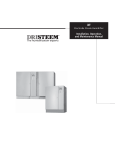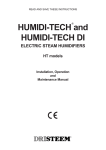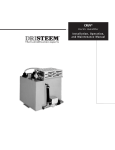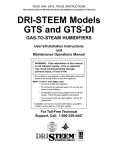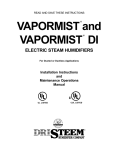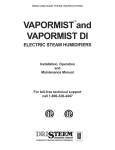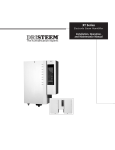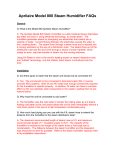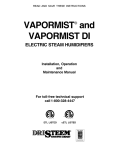Download Aprilaire Steam Humidifier FAQ`s
Transcript
Aprilaire Steam Humidifier FAQ’s General Question: What is an Aprilaire Steam Humidifier? Answer: An Aprilaire Steam Humidifier is a self-contained device that takes tap water and boils it, using electric immersion heaters, to create steam. The steam flows through a steam hose and is injected into a moving airstream by way of a distribution tube. The steam flows out of the distribution tube into the duct work through a series of small ‘tubelets’ which create an even, drip-free transfer of steam into the moving airstream. Question: What is the difference between Models 1150, 1160, and 1180? Answer: The Aprilaire Steam Humidifier Model 1150 is a 12 lbs/hr capacity unit which uses an ‘on/off’ Automatic Steam Humidifier Control. The Model 1160 is a 24 lbs/hr capacity unit which uses a ‘modulating’ Automatic Steam Humidifier Control. The Model 1180 is a 48 lbs/hr capacity unit which uses a ‘modulating’ Automatic Steam Humidifier Control. In addition to the higher capacity, the modulating control of the Model 1160 and 1180 allows for more flexibility in controlling indoor relative humidity. Installation Question: Are there types of water that the steam units should not be connected to? Answer: Yes. The units should not be connected to deionized water (DI) or reverse osmosis (RO) systems. Both DI & RO water lack the conductivity required to enable the water level probe control to properly function and allow the humidifier to operate. In addition, DI water can have a corrosive effect on the non-stainless steel components in the system, leading them to pre-mature failure. Question: How much hard piping can you use with the 10 ft. steam hose to extend the distance from the humidifier to the steam distribution tube? Answer: The issue is really about how much of a loss in steam capacity is acceptable because the shorter the distance from the steam humidifier to the distribution tube, the less steam loss there will be due to condensation. This is true whether using steam hose alone or in combination with hard copper tubing. The 1 ½ in. diameter steam hose supplied with Aprilaire Steam Humidifier Models 1150 and 1160 limits the loss to 0.15 lbs/hr for every foot of hose. When using non-insulated copper tubing of the same diameter, the loss is 0.11 lbs/hr for every foot of tubing. When using copper tubing with fiberglass insulation, the condensation loss drops to 0.02 lbs/hr for every foot of tubing. The 2 in. diameter steam hose supplied with Aprilaire Steam Humidifier Model 1180 limits the loss to 0.20 lbs/hr for every foot of hose. When using non-insulated copper tubing of the same diameter, the loss is 0.14 lbs/hr for every foot of tubing. When using copper tubing with fiberglass insulation, the condensation loss drops to 0.025 lbs/hr for every foot of tubing. Here’s an example: a Model 1150 is installed with a 10 ft run of steam hose along with an additional 15 ft run of insulated copper tubing. The nominal capacity of the 1150 is 12 lbs/hr. Steam loss in the hose: Steam loss in copper tubing: 10 (ft) x 0.15 (lbs/hr/ft) = 15 (ft) x 0.02 (lbs/hr/ft) = Net steam delivered to duct: 1.5 lbs/hr 0.3 lbs/hr 10.2 lbs/hr The example above is based on 80°F ambient air temperature and 2” fiberglass insulation. All manufacturers of steam humidifiers (such as Nortec, Carnes, Pure, Armstrong, Neptronic, and Dristeem) who use a hose and tube type system rate the output of the humidifier and the actual output is slightly less depending upon the length and type of hose or pipe used. Question: Do the steam hose and distribution have to be sloped back towards the humidifier? Answer: The steam hose and/or tubing must have a minimum pitch of 2”/ft from the distribution tube back to the humidifier to allow for condensation within the tube to fall back into the steam chamber. If the application configuration does not allow for this, a drip tee, P-trap, and drain must be installed at the steam distribution tube & hose connection point. Refer to the ‘Installation, Operation, and Maintenance Manual’ for more detailed information. Question: Is connecting the humidifier to 208 volt verses the recommended 240 volt electrical connection acceptable? Answer: Yes. Operating the Models 1150 and 1160 at 208 VAC, single-phase versus 240 VAC, single-phase will have no negative impact on the life of any part of the humidifier and will not affect the product warranty. The Model 1180 will also work with 208 VAC triple-phase, versus 240 VAC However, the capacity of the units will be less at the lower voltage. See below: 240 VAC Electrical Capacity Data 208 VAC Electrical Capacity Data 1150 240/1/60 12 lbs/hr 208/1/60 9 lbs/hr 1160 1180 240/1/60 240/3/60 24 lbs/hr 48 lbs/hr 208/1/60 208/3/60 18 lbs/hr 36 lbs/hr Model Question: What are the recommended minimum and maximum distances for installing the steam tube from HVAC equipment components such as the coil, filter, or blower? Answer: In order to prevent hot steam from condensing onto surfaces in the duct work such as coils, filters, blowers, elbows, or dampers, the steam distribution tube must not be installed immediately upstream of any such obstructions. In virtually all applications, 36” of clear, obstruction-free duct (return or supply) should be sufficient distance to allow for full absorption of the steam into the airstream. The ideal installation would be to install the distribution tube immediately downstream of the HVAC equipment in a long (>36”) and obstruction-free section of the duct. Factors that can reduce the actual distance required include: lower outdoor air requirements (higher return air temperature), higher airflow velocity, and lower humidity load. If your project does not allow for the recommended 36” of free and clear unobstructed duct run, Refer to the ‘Installation, Operation, and Maintenance Manual’ for more detailed information, including a procedure for calculating actual absorption distance for a given set of conditions. Question: Can flex duct be used in conjunction with Aprilaire Steam Humidifiers? Answer: In order to support the weight of the steam distribution tube and steam hose, the distribution tube must be installed in a solid section of the ductwork or plenum, allowing for minimum required absorption distance as described above. However, if absorption distance requirements have been met, there is no reason flex duct could not be used in either the supply or return branches. Question: What are the minimum airflow requirements for Aprilaire Steam humidifiers? Answer: In reality, this question applies to all applications. The minimum airflow relates to a bigger issue, duct saturation which can be the result of low air velocity in the ductwork. Once 90% RH is exceeded in the duct, the air starts to become saturated, (meaning that it cannot hold any more moisture) and it will start to condense on the duct work. This is especially critical in low CFM and low outside air applications, typical of residential variable speed equipment. When the humidifier calls the blower, at first it is typical of the variable speed furnace to run at a very low speed, as low as 200 CFM. The ductwork is sized for the maximum air delivery of the furnace system, and therefore when it is runs at a low speed, the velocity may be as low as 100 FPM. At these very low velocities, steam may actually be able to flow against the airflow, creating saturation in the duct. The solution to this problem is to maintain a minimum of 300 FPM velocity in the duct and install the high humidity limit switch as a precaution. The key here is to size the ductwork accordingly, or if the ductwork is existing, increase the airflow. Please see the formula and example below for calculating air velocity: CFM=DUCT AREA (in SQ FT) X VELOCITY (in Feet Per Minute, FPM) Example: If the job has a 400 CFM air flow and the duct is 20"x12"( 20X12/144=1.67 sq. ft.) , the velocity is 239 FPM. (400 CFM/ 1.67 sq. ft. in the duct = 239 FPM). By increasing the air flow to 500 CFM, we can deliver a velocity of 300 FPM. If we needed to stay at 400 CFM, we would need to modify the duct system to approximately 16"x12" (1.33 sq.ft.) to deliver 300 FPM. (400 CFM/300 FPM= 1.33 Sq ft). The problem with modifying the duct system for the low airflow is that the system would not perform properly at higher speeds as the velocity would be too high, creating excess noise, and the pressure will increase and may result in lower air flows than are acceptable. In most applications, it’s recommended the installing contractor simply increase the airflow to accommodate the humidifier. Unit Operation Question: How much water is in the steam chamber each unit? Answer: The operating capacity of the steam chamber in the Model 1150 is 1.4 gallons of water, the operating capacity of the Model 1160 is 2.0 gallons, and the operating capacity of the Model 1180 is 3.7 gallons. Question: How long does it take the units to fill the steam chamber and bring the water to boil? Answer: Starting from an empty steam chamber, it takes just under 10 minutes for the units to fill the tank with water and bring the water to boil. If the tank is full but the water is cold because there has not been a call for humidity for some time, it will take between 6 and 7 ½ minutes for the water to come to a boil. Question: What are the lengths of time between drain intervals based on varying water conditions? Answer: When the Steam Humidifier is installed, a ‘water type’ dip-switch setting is configured by the installer according to the water being supplied to the unit. The Steam Humidifier will initiate auto drain cycles of the steam chamber at different times based on this water type setting. For ‘Normal’ water (hardness greater than 4 but less than 10 grains/gallon) the humidifier will attempt to initiate the auto drain sequence after 36 hours of heater operation. If there is a humidity demand at that time it will not drain. Instead it will wait until the 72nd hour of heater run time. At that point the auto drain sequence will override a humidity demand signal and the unit will drain. The cycle is then repeated. For ‘Hard’ water (hardness greater than or equal to 10 grains/gallon) the humidifier will attempt to initiate the auto drain sequence after 24 hours of heater operation. If there is a humidity demand at that time it will not drain. Instead it will wait until the 36th hour of heater run time. At that point the auto drain sequence will override a humidity demand signal and the unit will drain. The cycle is then repeated. For ‘Soft’ or ‘Softened’ water (hardness less than or equal to 4 grains/gallon) the humidifier will attempt to initiate the auto drain sequence after 160 hours of heater operation. If there is a humidity demand at that time it will not drain. Instead it will wait until 240 hours of heater run time. At that point the auto drain sequence will override a humidity demand signal and the unit will drain. The cycle is then repeated. The settings above are based on laboratory and field tests of standard units and may not be applicable for every application. Also, not all water softeners work equally; as a result, it may be beneficial to increase the auto drain frequency by configuring the water type setting for hard water even if using Softened water. Question: What are the power requirements for each unit? Answer: The Model 1150 uses one 4 kW heater, the Model 1160 uses two 4 kW heaters for 8 kW total, and the Model 1180 uses three 5.33 kW heaters for 16 kW total. The current draw at 240 VAC is 16.7 Amps for the Model 1150, 33.3 Amps for the Model 1160, and the current draw for the Model 1180 at 240/3/60 is 38.5 Amps. The Model 1150 requires a 25 Amp (minimum) circuit breaker, the Models 1160 and 1180 requires a 50 Amp (minimum) circuit breaker. Question: What is the operating weight of the units? Answer: The operating weight for a Model 1150 with a full steam chamber is 67 lbs. The Model 1160 operating weight is 74 lbs, and the Model 1180 operating weight is 116 lbs. Question: There was a pungent smell coming from the steam hose the first time the unit was started up. Is this normal? Answer: Yes. When the rubber in the steam hose is heated up the first time, a strong odor may be present for about 15-30 minutes. This will only occur during the initial period of operation. Automatic Steam Humidifier Control Operation Can the Automatic Steam Humidifier Control be used to control more than 1 Aprilaire Steam humidifier? Answer: No, the Automatic Steam Humidifier Control is designed to be powered from one humidifier and then send a command signal back to that one humidifier. Connecting a control to more than one unit could cause unpredictable operation. Question: If used in conjunction with the Aprilaire Model 8570 thermostat, will the humidity level be displayed? Answer: Yes. If the serial output (I+, I-) from the Automatic Steam Humidifier Control is connected to the corresponding terminals on the Aprilaire 8570 thermostat, the thermostat will display the indoor relative humidity. In addition, it will display the outdoor temperature, assuming the outdoor temperature sensor is connected to the Humidifier Control. Note that the indoor humidity will only be displayed on the 8570 when the blower is running. Question: Can the Aprilaire Model 8570 thermostat be used in conjunction with the ‘blower control by the humidifier’ feature of the humidifier? Answer: No. The humidifier cannot turn on the blower to satisfy a demand for humidity when the serial outputs from the Automatic Steam Humidifier Control are connected to the Model 8570 thermostat. In this application, the 8570 thermostat will only allow the humidifier to operate during heating calls or thermostat-controlled fan calls. Question: Can the Model 8870 Communicating Thermostat be used to control Aprilaire Steam Humidifiers? Answer: The Model 8870 can be used with the Model 1150 because requires a 0 VDC and 10 VDC ‘on/off’ signal and Model 8870 can provide a 0 VDC dry contact. The Model 1160 and 1180 require a 0-10 VDC or 4-20 mA ‘modulating’ signal. The 8870 thermostat does not provide such output. Question: What is ‘on/off’ versus ‘modulation’ control in the Automatic Steam Humidifier Control? Answer: With the on/off control used in the Model 1150, the Control tells the Steam Humidifier to either be ‘full on’ or ‘off’ – nothing in between. This is fine for many applications. With the modulating control used in the Model 1160 and 1180, the output of the Control, and hence the Steam Humidifier, is a proportion of maximum output based on how far the measured RH is from the setpoint RH. The output of the Steam Humidifier is varied by turning the heaters on and off at a rate that changes as the measured RH approaches the setpoint RH. It is a method for ‘throttling’ the Steam Humidifier with the end result being a more precise control of indoor RH. Question: On the left hand side of the Automatic Steam Humidifier Control – under the wiring access door – there is a potentiometer knob. What does this do? And what is the importance of the proportional control band? Answer: For the Model 1150 On/Off Control, the potentiometer is not active. The potentiometer is functional only when the Control is used with a Model 1160 and 1180, which is when the control is configured for modulation. This potentiometer is designed to allow for flexibility in operation as far as the response time to meet humidification requirements. There are 4 positions: 6, 9, 12 (factory setting), and 15. These numbers refer to the ‘proportional control band,’ and the lower the number, the faster the response time to meet the humidification need as the control modulates. The larger the number, the longer the time it will take to respond to the humidity requirement. The main difference is that at a lower number setting, the humidifier responds quickly but the result can be more on/off cycles than desired as it reaches set point. This means it’s possible to hear the contactor clicking on and off rapidly as the humidity level reaches set point. By increasing to a higher number on the potentiometer, the rapid cycling is reduced, and as a result the control responds slower to meet the humidity need. Question: What is the humidity operating range of the Automatic Steam Humidifier Control? Answer: 15% to 55% RH. Question: When installed in the automatic mode, does the Automatic Steam Humidifier Control turn off when the outdoor temperature is above a certain temperature? Answer: Yes. When the Automatic Steam Humidifier Control is installed in the automatic mode, the humidifier will not operate if the outdoor temperature is above 60°F. Can the unit be operated based on a “signal by others” if there is a building automation system present in the building? Answer: Yes. The unit is capable of operating on a 0-10 vdc or 4-20 mA signal as provided by others. Please refer to the unit configuration portion of the Installation and Safety manual for humidifier set-up. Maintenance Question: What kind and frequency of maintenance is required for these units? Answer: Yearly cleaning of the steam chamber, drain piping, and water level probe is all that is typically required. The use of naturally-occurring soft water, or water treated by an ion exchange softener, may extend the required maintenance interval.







